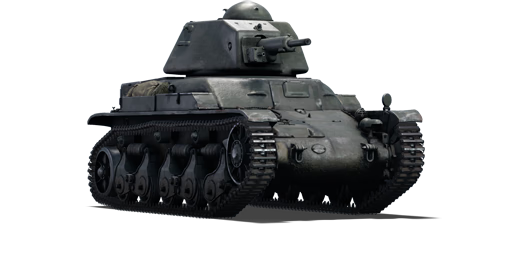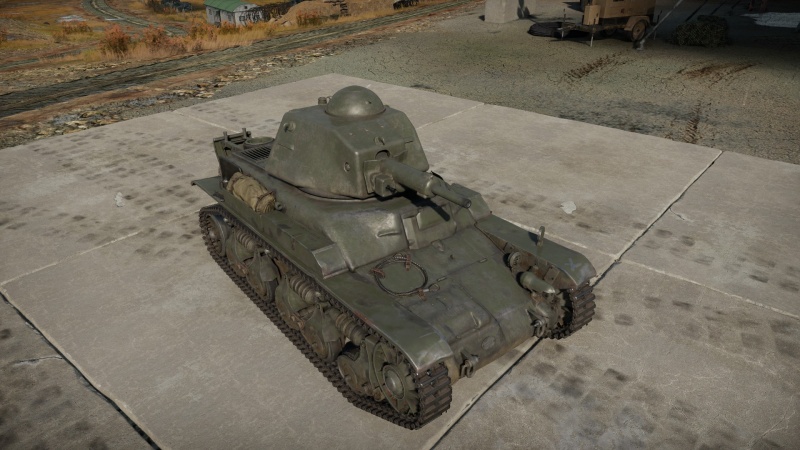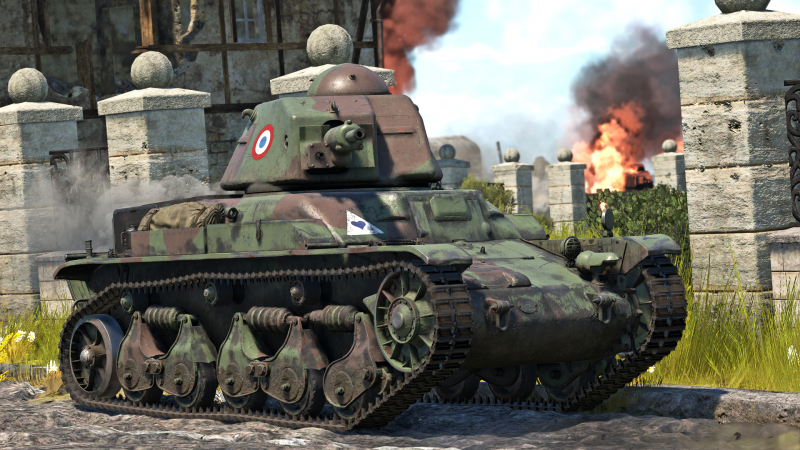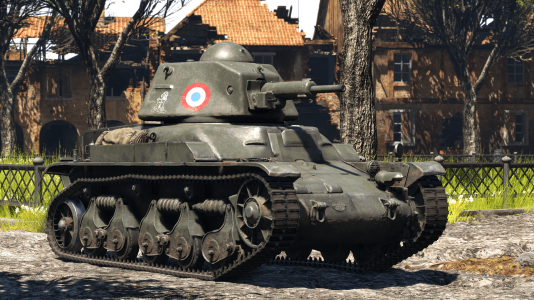Difference between revisions of "R.35 (SA38)"
Colok76286 (talk | contribs) (Edits) |
(New Specs-Card Artimage. Old picture moved to Media: Images) |
||
| (7 intermediate revisions by 4 users not shown) | |||
| Line 1: | Line 1: | ||
{{Specs-Card | {{Specs-Card | ||
|code=fr_renault_r39 | |code=fr_renault_r39 | ||
| − | |images={{Specs-Card-Image|GarageImage_{{PAGENAME}}.jpg| | + | |images={{Specs-Card-Image|GarageImage_{{PAGENAME}}.jpg|ArtImage2_{{PAGENAME}}.png}} |
}} | }} | ||
== Description == | == Description == | ||
<!-- ''In the description, the first part should be about the history of the creation and combat usage of the vehicle, as well as its key features. In the second part, tell the reader about the ground vehicle in the game. Insert a screenshot of the vehicle, so that if the novice player does not remember the vehicle by name, he will immediately understand what kind of vehicle the article is talking about.'' --> | <!-- ''In the description, the first part should be about the history of the creation and combat usage of the vehicle, as well as its key features. In the second part, tell the reader about the ground vehicle in the game. Insert a screenshot of the vehicle, so that if the novice player does not remember the vehicle by name, he will immediately understand what kind of vehicle the article is talking about.'' --> | ||
| − | The '''{{Specs|name}}''' | + | The '''{{Specs|name}}''' was the most common tank in the French Armed Forces at the start of WWII, with 900 units in active service. The tank was doctrinally intended for infantry support, being fielded in infantry tank battalions, as such, the vehicle had a very poor anti-tank performance. Not all R.35s received the SA 38 gun, instead, H.35s and H.39s had priority in this aspect. A limited version of the R.35 sometimes referred as R.40 saw limited service. A few were used by the French Resistance during the fall of Paris in 1944. |
| − | + | It was introduced in [[Update 1.75 "La Résistance"]] as the R.39 and was subsequently renamed R.35 (SA38) in [[Update 1.89 "Imperial Navy"]]. The R.35 is in many ways similar to the other light tanks in the lower French tech tree; mobility is exchanged for thicker armour. It also has the other well-known features like a one-man turret and a decent gun with poor post-penetration damage. The reload time is longer than that of most tanks at its rank, but this is usually overcome by its low silhouette and thick side armour. It shares many of its shortcomings with other French tanks of rank I, so players should already be used to the playstyle. It is overall a decent vehicle, with very potent armour and a sluggish top speed. | |
== General info == | == General info == | ||
| Line 14: | Line 14: | ||
{{Specs-Tank-Armour}} | {{Specs-Tank-Armour}} | ||
<!-- ''Describe armour protection. Note the most well protected and key weak areas. Appreciate the layout of modules as well as the number and location of crew members. Is the level of armour protection sufficient, is the placement of modules helpful for survival in combat? If necessary use a visual template to indicate the most secure and weak zones of the armour.'' --> | <!-- ''Describe armour protection. Note the most well protected and key weak areas. Appreciate the layout of modules as well as the number and location of crew members. Is the level of armour protection sufficient, is the placement of modules helpful for survival in combat? If necessary use a visual template to indicate the most secure and weak zones of the armour.'' --> | ||
| − | With good armour thickness and surprising hull angles, this tank can take some beating at a distance, provided you do not get a lucky shot in the turret ring or that you face a heavy-hitting gun. This should get you into effective combat ranges (500 - m) in relative safety. The most obvious | + | With good armour thickness and surprising hull angles, this tank can take some beating at a distance, provided you do not get a lucky shot in the turret ring or that you face a heavy-hitting gun. This should get you into effective combat ranges (500- m) in relative safety. The most obvious weak spot is its turret flat left side, which is only 45 mm thick and badly angled, this makes hull-down position ineffective. |
With its heavy side armour, one should use angles at its advantages and angle it at about 35° while facing opponents. Such an angling gives about 60 mm of effective thickness for 80% of the exposed area. | With its heavy side armour, one should use angles at its advantages and angle it at about 35° while facing opponents. Such an angling gives about 60 mm of effective thickness for 80% of the exposed area. | ||
| Line 79: | Line 79: | ||
==== Ammunition ==== | ==== Ammunition ==== | ||
| − | { | + | {{:SA38 L/33 (37 mm)/Ammunition|Mle1938}} |
| − | |||
| − | |||
| − | |||
| − | |||
| − | |||
| − | |||
| − | |||
| − | |||
| − | |||
| − | |||
| − | |||
| − | { | ||
| − | |||
| − | |||
| − | |||
| − | |||
| − | |||
| − | |||
| − | |||
| − | |||
| − | |||
| − | |||
| − | |||
| − | |||
| − | |||
| − | | Mle1938 | ||
| − | |||
| − | |||
==== [[Ammo racks]] ==== | ==== [[Ammo racks]] ==== | ||
| Line 146: | Line 118: | ||
'''Gameplay summary:''' | '''Gameplay summary:''' | ||
| − | The R.35 is a decent light tank for its battle rating, so long as it is played with the right tactics. The most important aspect of R.35 gameplay is armour angling. Being that the side armour is actually thicker than the front armour, angling at 45 degrees or more is ideal. The tank is not particularly quick | + | The R.35 is a decent light tank for its battle rating, so long as it is played with the right tactics. The most important aspect of R.35 gameplay is armour angling. Being that the side armour is actually thicker than the front armour, angling at 45 degrees or more is ideal. The tank is not particularly quick which means flanking is generally difficult. Sticking with your team is therefore the best strategy. Generally, medium range engagements are ideal, though it can hold its ground in other scenarios. Its low silhouette can also be used to hide behind obstacles, go hull-down and slip below an enemies' gun depression angle. |
'''Close Range Engagements:''' | '''Close Range Engagements:''' | ||
| − | The R.35 is capable at close range, although the slow reload can cause issues. The armour if angled correctly may bounce enemy rounds even at point blank range, however the R.35 must disable the enemy tank with the first shot. Most enemies that the R.35 will face have a faster reload, and may be able to outmanoeuvre it, as the R.35 is somewhat slow. This means that getting too close to the enemy is a mistake, always maintain some distance with quick enemies. | + | The R.35 is capable at close range, although the slow reload can cause issues. The armour if angled correctly may bounce enemy rounds even at point blank range, however the R.35 must disable the enemy tank with the first shot. Most enemies that the R.35 will face have a faster reload, and may be able to outmanoeuvre it, as the R.35 is somewhat slow. This means that getting too close to the enemy is a mistake, always maintain some distance with quick enemies. The tank however does turn surprisingly quick compared to its underwhelming turret traverse, so if you want to have your gun on target quicker in a brawl you can just turn your entire vehicle to line up your gun with the enemy's soft spots. |
'''Long Range Engagements:''' | '''Long Range Engagements:''' | ||
| − | The R.35 will struggle to deal damage at long range, the cannon having mediocre penetration and reload. However staying at range can also be a good strategy, as enemies may struggle to penetrate the armour of the R.35 as well. | + | The R.35 will struggle to deal damage at long range, the cannon having mediocre penetration and reload. However staying at range can also be a good strategy, as enemies may struggle to penetrate the armour of the R.35 as well. The gun doesn't outshine its common adversaries at range, but considering your enemy is very likely to possess armour inferior to the R.35's, you can still beat most vehicles at this rank (except tank destroyers). |
'''Notable Enemies:''' | '''Notable Enemies:''' | ||
| − | Some notable enemies include: any German vehicles that use 20 mm autocannons, these include [[Pz.II ( | + | Some notable enemies include: any German vehicles that use 20 mm autocannons, these include [[Pz.II (Family)|Panzer II]] and [[Flakpanzer I|Flankpanzer]] tanks. Their autocannons will easily destroy the R.35 if the armour is not angled. Additionally, the R.35 struggles to penetrate Panzer II tanks. |
Additionally, the R.35 will be easily penetrated by enemy vehicles equipped with the American [[M3 (37 mm)|37 mm M3]] cannon, the British [[QF 2-pounder (40 mm)|QF 2-pounder]] gun, or the Swedish [[Kan m/38 (37 mm)|37 mm kan m/38]] gun. | Additionally, the R.35 will be easily penetrated by enemy vehicles equipped with the American [[M3 (37 mm)|37 mm M3]] cannon, the British [[QF 2-pounder (40 mm)|QF 2-pounder]] gun, or the Swedish [[Kan m/38 (37 mm)|37 mm kan m/38]] gun. | ||
| Line 184: | Line 156: | ||
<!-- ''Describe the history of the creation and combat usage of the vehicle in more detail than in the introduction. If the historical reference turns out to be too long, take it to a separate article, taking a link to the article about the vehicle and adding a block "/History" (example: <nowiki>https://wiki.warthunder.com/(Vehicle-name)/History</nowiki>) and add a link to it here using the <code>main</code> template. Be sure to reference text and sources by using <code><nowiki><ref></ref></nowiki></code>, as well as adding them at the end of the article with <code><nowiki><references /></nowiki></code>. This section may also include the vehicle's dev blog entry (if applicable) and the in-game encyclopedia description (under <code><nowiki>=== In-game description ===</nowiki></code>, also if applicable).'' --> | <!-- ''Describe the history of the creation and combat usage of the vehicle in more detail than in the introduction. If the historical reference turns out to be too long, take it to a separate article, taking a link to the article about the vehicle and adding a block "/History" (example: <nowiki>https://wiki.warthunder.com/(Vehicle-name)/History</nowiki>) and add a link to it here using the <code>main</code> template. Be sure to reference text and sources by using <code><nowiki><ref></ref></nowiki></code>, as well as adding them at the end of the article with <code><nowiki><references /></nowiki></code>. This section may also include the vehicle's dev blog entry (if applicable) and the in-game encyclopedia description (under <code><nowiki>=== In-game description ===</nowiki></code>, also if applicable).'' --> | ||
| − | The Char Leger | + | The Char Leger 1935 Renault (Renault Light Tank model 1935), armed with the SA 18 short 37 mm gun, was the most common French tank at the onset of the war in Europe, with 900 on active service in infantry tank battalions in May, 1940. However, like its competitor H.35, its gun was known to be unsatisfactory as an anti-tank weapon. |
Only a few of these R.35s could be converted to the improved SA 38 main gun prior to the fall of France, with the H.35s and H.39s of the cavalry receiving priority. It is known the 1st (Free) Polish Tank Regiment in France near Paris did receive some converted R.35s in May, 1940. These upgunned R.35 tanks are sometimes referred to (erroneously) as the R.39. | Only a few of these R.35s could be converted to the improved SA 38 main gun prior to the fall of France, with the H.35s and H.39s of the cavalry receiving priority. It is known the 1st (Free) Polish Tank Regiment in France near Paris did receive some converted R.35s in May, 1940. These upgunned R.35 tanks are sometimes referred to (erroneously) as the R.39. | ||
| Line 192: | Line 164: | ||
== Media == | == Media == | ||
<!-- ''Excellent additions to the article would be video guides, screenshots from the game, and photos.'' --> | <!-- ''Excellent additions to the article would be video guides, screenshots from the game, and photos.'' --> | ||
| + | |||
| + | ;Images | ||
| + | <gallery mode="packed-hover" heights="200"> | ||
| + | File:ArtImage R.35 (SA38).png | ||
| + | </gallery> | ||
;Skins | ;Skins | ||
| Line 197: | Line 174: | ||
;Videos | ;Videos | ||
| − | {{Youtube-gallery|GCdwnUEASg8|'''Char léger d'accompagnement 1939 R, French, Tier-1, Light Tank''' - ''Angry Nerd Gaming | + | {{Youtube-gallery|GCdwnUEASg8|'''Char léger d'accompagnement 1939 R, French, Tier-1, Light Tank''' - ''Angry Nerd Gaming''}} |
== See also == | == See also == | ||
| Line 205: | Line 182: | ||
;Other vehicles of similar configuration and role | ;Other vehicles of similar configuration and role | ||
| + | |||
* [[H.39]] | * [[H.39]] | ||
* [[H.39 "Cambronne"]] | * [[H.39 "Cambronne"]] | ||
Latest revision as of 23:35, 17 July 2024
Contents
Description
The Char léger d'accompagnement 1935 R (SA38) was the most common tank in the French Armed Forces at the start of WWII, with 900 units in active service. The tank was doctrinally intended for infantry support, being fielded in infantry tank battalions, as such, the vehicle had a very poor anti-tank performance. Not all R.35s received the SA 38 gun, instead, H.35s and H.39s had priority in this aspect. A limited version of the R.35 sometimes referred as R.40 saw limited service. A few were used by the French Resistance during the fall of Paris in 1944.
It was introduced in Update 1.75 "La Résistance" as the R.39 and was subsequently renamed R.35 (SA38) in Update 1.89 "Imperial Navy". The R.35 is in many ways similar to the other light tanks in the lower French tech tree; mobility is exchanged for thicker armour. It also has the other well-known features like a one-man turret and a decent gun with poor post-penetration damage. The reload time is longer than that of most tanks at its rank, but this is usually overcome by its low silhouette and thick side armour. It shares many of its shortcomings with other French tanks of rank I, so players should already be used to the playstyle. It is overall a decent vehicle, with very potent armour and a sluggish top speed.
General info
Survivability and armour
With good armour thickness and surprising hull angles, this tank can take some beating at a distance, provided you do not get a lucky shot in the turret ring or that you face a heavy-hitting gun. This should get you into effective combat ranges (500- m) in relative safety. The most obvious weak spot is its turret flat left side, which is only 45 mm thick and badly angled, this makes hull-down position ineffective.
With its heavy side armour, one should use angles at its advantages and angle it at about 35° while facing opponents. Such an angling gives about 60 mm of effective thickness for 80% of the exposed area.
In an ambush position, this tank could face its opponents backwards (engine deck first). This unusual tactic could confuse enemies for a moment and provide extra protection as your engine may absorb shots. This will also decrease the chances of a lucky penetration : if turret is facing enemy, almost 90% of exposed surfaces have ~60 + mm of LoS thickness. If danger gets too high, you could give it the gas and "fly" away in forward motion.
Armour type:
- Cast homogeneous armour (hull, turret, cupola)
- Rolled homogeneous armour (front glacis, engine vents)
- Structural steel (mudguards, trench-crossing tail, storage boxes, exhaust cover)
| Armour | Front (Slope angle) | Sides | Rear | Roof |
|---|---|---|---|---|
| Hull | 32 mm (23-61°) Upper plate 32 mm (23°) Driver hatch 25 mm (74°) Front glacis 32 mm (24-26°) Lower plate 32 mm (cylindrical) Lower glacis |
40 mm (4-28°) Top 40 mm Bottom |
40 mm (12°) Top 40 mm (33°) Bottom |
25 mm (16°) Front glacis 25 mm Centre 25 mm (1-6°) Rear 5 mm Engine vents |
| Turret | 45 mm (4-28°) Turret front 45 mm (28-30°) Left side 25 mm (10-11°) + 45 mm (4°) Gun mantlet |
40 mm (0-28°) | 40 mm (30°) | 25 mm (22°) Front 25 mm Centre and rear |
| Cupola | 40 mm (cylindrical) Base 40 mm (spherical) Dome | |||
Notes:
- Suspension wheels, bogies and tracks are 15 mm thick.
- The trench-crossing tail is 5 mm thick and the mudguards are 4 mm thick.
Mobility
| Game Mode | Max Speed (km/h) | Weight (tons) | Engine power (horsepower) | Power-to-weight ratio (hp/ton) | |||
|---|---|---|---|---|---|---|---|
| Forward | Reverse | Stock | Upgraded | Stock | Upgraded | ||
| Arcade | 23 | 4 | 11 | 89 | 156 | 8.09 | 14.18 |
| Realistic | 20 | 3 | 73 | 82 | 6.64 | 7.45 | |
The mobility is the R.35 (SA38)'s biggest weakness: while it does not like long-range engagements and needs to close-up with its foes in order to damage them, its very low speed will always leave it far behind its allies. With its narrow tracks and poor power ratio (8.09 HP/ton), the R.35 (SA38) hates being taken out in the mud as its speeds fall drastically. 20 km/h forward and -3 km/h backwards is all you'll get from this struggling 73 HP engine. Plan your moves in advance and do not stay too near to the front line as a successful retreat is hard to achieve with such a slow tank.
Modifications and economy
Armaments
Main armament
| 37 mm SA38 L/33 | Turret rotation speed (°/s) | Reloading rate (seconds) | |||||||||||
|---|---|---|---|---|---|---|---|---|---|---|---|---|---|
| Mode | Capacity | Vertical | Horizontal | Stabilizer | Stock | Upgraded | Full | Expert | Aced | Stock | Full | Expert | Aced |
| Arcade | 58 | -8°/+12° | ±180° | Shoulder | 14.9 | 20.7 | 25.1 | 27.8 | 29.6 | 5.20 | 4.60 | 4.24 | 4.00 |
| Realistic | 9.3 | 11.0 | 13.3 | 14.8 | 15.7 | ||||||||
The 37 mm SA38 cannon has significantly better penetration and post-penetration damage than its predecessor, but has a longer reload rate than its peers. Know the layout of enemy vehicles well, target their gunners first or immobilize them by shooting at the engine, and make every shot count. Avoid exchanging shots at long distances as your gun's penetration values decrease heavily beyond 500 m. The turret traverse speed is also an issue since you'll not be able to react in time to flanking opponents.
Ammunition
| Penetration statistics | |||||||
|---|---|---|---|---|---|---|---|
| Ammunition | Type of warhead |
Penetration @ 0° Angle of Attack (mm) | |||||
| 10 m | 100 m | 500 m | 1,000 m | 1,500 m | 2,000 m | ||
| Mle1938 | APC | 54 | 50 | 36 | 24 | 16 | 11 |
| Shell details | ||||||||||||
|---|---|---|---|---|---|---|---|---|---|---|---|---|
| Ammunition | Type of warhead |
Velocity (m/s) |
Projectile mass (kg) |
Fuse delay | Fuse sensitivity (mm) |
Explosive mass (TNT equivalent) (g) |
Ricochet | |||||
| 0% | 50% | 100% | ||||||||||
| Mle1938 | APC | 705 | 0.7 | - | - | - | 48° | 63° | 71° | |||
Ammo racks
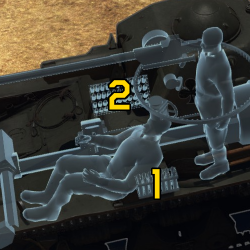
| Full ammo |
1st rack empty |
2nd rack empty |
Visual discrepancy |
|---|---|---|---|
| 58 | 45 (+13) | 1 (+57) | No |
Note:
- As they are modeled by sets of 2, shells disappear from the rack only after you fire both shells in the set.
Machine guns
| 7.5 mm MAC 31 | ||||
|---|---|---|---|---|
| Mount | Capacity (Belt) | Fire rate | Vertical | Horizontal |
| Coaxial | 1,800 (150) | 551 | N/A | N/A |
The small calibre of the MAC 31 machine gun makes it largely ineffective against all armoured vehicles but the ones with an open compartment. It still can be used to ping targets as a rangefinding help or to mow down minor obstacles blocking your line of sight.
Usage in battles
Gameplay summary:
The R.35 is a decent light tank for its battle rating, so long as it is played with the right tactics. The most important aspect of R.35 gameplay is armour angling. Being that the side armour is actually thicker than the front armour, angling at 45 degrees or more is ideal. The tank is not particularly quick which means flanking is generally difficult. Sticking with your team is therefore the best strategy. Generally, medium range engagements are ideal, though it can hold its ground in other scenarios. Its low silhouette can also be used to hide behind obstacles, go hull-down and slip below an enemies' gun depression angle.
Close Range Engagements:
The R.35 is capable at close range, although the slow reload can cause issues. The armour if angled correctly may bounce enemy rounds even at point blank range, however the R.35 must disable the enemy tank with the first shot. Most enemies that the R.35 will face have a faster reload, and may be able to outmanoeuvre it, as the R.35 is somewhat slow. This means that getting too close to the enemy is a mistake, always maintain some distance with quick enemies. The tank however does turn surprisingly quick compared to its underwhelming turret traverse, so if you want to have your gun on target quicker in a brawl you can just turn your entire vehicle to line up your gun with the enemy's soft spots.
Long Range Engagements:
The R.35 will struggle to deal damage at long range, the cannon having mediocre penetration and reload. However staying at range can also be a good strategy, as enemies may struggle to penetrate the armour of the R.35 as well. The gun doesn't outshine its common adversaries at range, but considering your enemy is very likely to possess armour inferior to the R.35's, you can still beat most vehicles at this rank (except tank destroyers).
Notable Enemies:
Some notable enemies include: any German vehicles that use 20 mm autocannons, these include Panzer II and Flankpanzer tanks. Their autocannons will easily destroy the R.35 if the armour is not angled. Additionally, the R.35 struggles to penetrate Panzer II tanks.
Additionally, the R.35 will be easily penetrated by enemy vehicles equipped with the American 37 mm M3 cannon, the British QF 2-pounder gun, or the Swedish 37 mm kan m/38 gun.
Pros and cons
Pros:
- Gun with a good penetration power
- Has decent sloped hull armour
- Has a very thick gun mantlet area
- Thick sides allows for heavy angling
Cons:
- Thin turret ring.
- Limited crew count: 2 members (easy to immobilize with a single shot)
- Extremely low speed, with bad cross-country and hill-climbing ability
- Awful reverse speed of -3 km/h
- Single type of ammunition, with no explosive filler
- Slow reload speed
History
The Char Leger 1935 Renault (Renault Light Tank model 1935), armed with the SA 18 short 37 mm gun, was the most common French tank at the onset of the war in Europe, with 900 on active service in infantry tank battalions in May, 1940. However, like its competitor H.35, its gun was known to be unsatisfactory as an anti-tank weapon.
Only a few of these R.35s could be converted to the improved SA 38 main gun prior to the fall of France, with the H.35s and H.39s of the cavalry receiving priority. It is known the 1st (Free) Polish Tank Regiment in France near Paris did receive some converted R.35s in May, 1940. These upgunned R.35 tanks are sometimes referred to (erroneously) as the R.39.
Concurrently, in 1939, AMX had developed a new type of track and suspension for the R.35, which had continued to be produced. This new variant, also armed with the SA 38, and sometimes designated the R.40, had gone into production in March, 1940. It saw limited service, but it is known the 40th and 48th tank battalions had received 30 each, and the 1st Polish as many as another 25, in time to serve in the invasion and fall of France. Some of these were still around to be seized by French Resistance forces during the fall of Paris in 1944.
Media
- Images
- Skins
- Videos
See also
- Other vehicles of similar configuration and role
External links
| France light tanks | |
|---|---|
| AMC.34/35 | AMC.34 YR · AMC.35 (ACG.1) |
| H.35/39 | H.35 · H.39 · H.39 "Cambronne" |
| AMX-13 | AMX-13 (FL11) · AMX-13-M24 · AMX-13 · AMX-13 (SS.11) · AMX-13-90 · AMX-13 (HOT) |
| Wheeled | AML-90 · AMX-10RC · Vextra 105 |
| AMD.35 | AMD.35 · AMD.35 (SA35) |
| E.B.R. | E.B.R. (1951) · E.B.R. (1954) · E.B.R. (1963) |
| Other | FCM.36 · R.35 (SA38) · Char 25t · MARS 15 · VBCI-2 (MCT30) |
| Austria | SK-105A2 |
| Great Britain | ▄Crusader Mk.II |
| Netherlands | CV 9035NL |
| USA | LVT-4/40 · ▄M3A3 Stuart |


